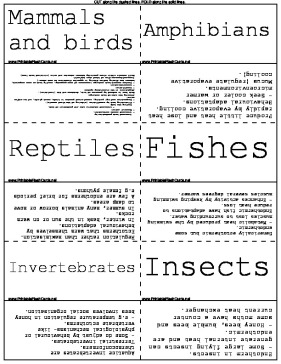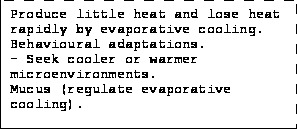

Learn the heat balance for insects, mammals, and birds with this biology word search
There are 6 flash cards in this set (1 page to print.)
To use:
1. Print out the cards.
2. Cut along the dashed lines.
3. Fold along the solid lines.
Sample flash cards in this set:




| Questions | Answers |
|---|---|
| Mammals and birds | � Increased heat production by - Increased muscle contraction. - Hormonal action - increased metabolic rate and production of heat. � Cooling the body - Eliminating heat by vasodilation (widening of the blood vessels). - Evaporative cooling- panting, vascularised pouches in birds, sweat glands, saliva and/or urine. Altering the rate of heat exchange: Heat loss is reduced by presence of hair, feathers and fat (insulation). Adaptations in the circulatory system: - Vasodilation - Vasoconstriction - Counter current heat exchange (crossover of some property, usually heat or some component, between two flowing bodies flowing in opposite directions to each other.) Increase/decrease flow of blood when hot/cold. Small vessels within close proximity between arteries and veins (minimised heat loss). |
| Amphibians | Produce little heat and lose heat rapidly by evaporative cooling. Behavioural adaptations. - Seek cooler or warmer microenvironments. Mucus (regulate evaporative cooling). |
| Reptiles | Regulation rather than maximisation. Ectotherms that warm themselves by behavioural adaptations. In winter, bask in the sun or on warm rocks. In summer, many animals borrow or move to damp areas. A few are endotherms for brief periods e.g female pythons. |
| Fishes | Generically ectothermic but some endothermic. - Metabolic heat produced by the swimming muscles lost to surrounding water. Endothermic fish have adaptations to reduce heat loss. - Enhances activity by keeping swimming muscles several degrees warmer. |
| Invertebrates | Aquatice invertebrates are thermoconformers. Terrestrial invertebrates. - Some do adjust by behavioural or physiological mechanisms- like vertebrate ectotherms. - e.g temperature regulation in honey bees involves social organisation. |
| Insects | Endotherm in insects. - Some large flying insects can generate internal heat and are endothermic. - Honey bees, bumble bees and some moths have a counter current heat exchanger. |